Boiler external mountings
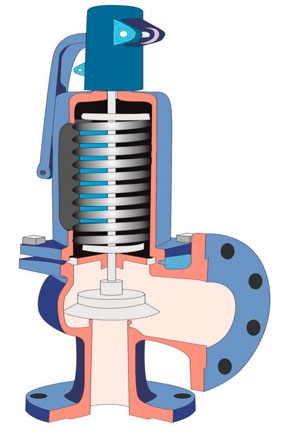
The boiler steam drum is fitted with several internal and external mountings for ensuring the safety and efficiency of the boiler steam system. These mountings are important mechanical components that need to be maintained for trouble-free operation. Following are the important external mountings fitted over the boiler:
Safety Valves: Safety valve are fitted in two numbers (pairs) to ensure that the boiler does not over-pressurize else it may lead to explosion of the pressure vessel.
The two safety valves are set at different pressures; one is set slightly lower than the other. If one safety valve does not lift due to malfunctioning, there is always a back up valve to safeguard the boiler.
Main Steam Valve: The steam generated in the boiler is delivered to the engine room system through the main steam stop valve. The function of this valve is to isolate the steam boiler and pressure from the rest of the system. It is generally an angle type globe valve of screw down mechanism.
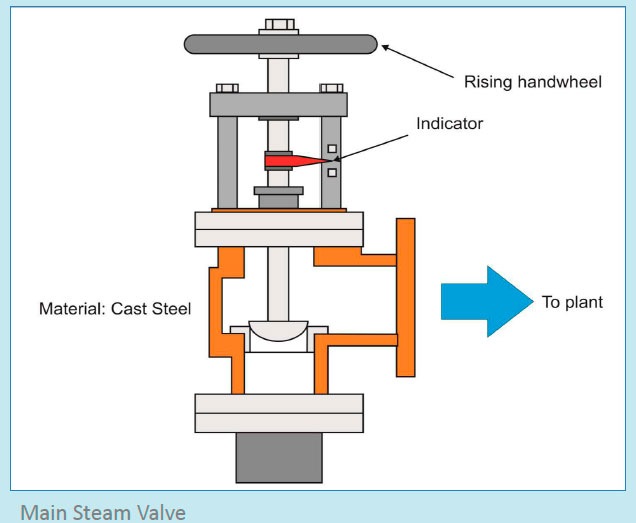
The stop valves are not meant for throttling and should be either in fully open or closed position.
It is important to open the stop valve very slowly in order to avoid sudden downstream pressure rise and effect of water hammering.
Bypass valve: This valve is installed in high-pressure boilers to equalize the pressure between the boiler and the steam system, when the main steam stop valve is in shut off position. It is basically a type of shut off valve.
Vent Valve: An air vent valve is provided on top of the steam drum to vent the air when the boiler is initially filled or drained with water. The air vent valve is also kept open during firing up of the boiler from cold condition and once the steam starts coming out, the vent is closed.
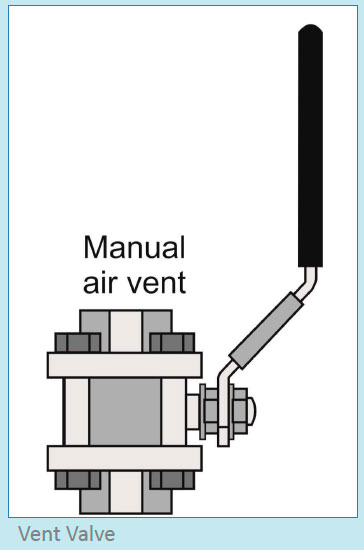
The vent valve should positively be opened when the boiler is taken off service, or else with dropping pressure and air vent closed, implosion of drum can occur.
The discharge of the vent is generally provided with a copper pipe, whose end is to be kept near the drain and properly visible while operating the boiler in above-mentioned condition. This is a type of shut off valve.
Feed Water Valves: Feed water check valve is installed between the boiler and the feed water pump. The feed water stop valve is fitted close to the boiler drum. The check valve includes a spring equivalent to the head of water in the elevated feed-tank when there is no pressure in the boiler. This prevents the boiler from flooding by the static head from the boiler feed tank.
The temperature of feed water is kept below 100 °C and therefore ethylene propylene soft seals are used for check valves.
Boiler Gauge Glasses: A gauge glass shows the current level of water in the boiler, regardless of the boiler’s operating conditions. Marine boiler is provided with two independent water level gauge glasses, which are located in front of the boiler, such that their lowest readings show the water level at least 50mm above the point of overheating of the boiler.
The gauges are also provided with a shut down valve, drain cocks for gauge glass blow-down, and a protector. The protector should not hinder the visibility of the correct water level. The pipes connected to the drain cock should be such that it opens in the boiler tray near the drain and is visible for inspection.
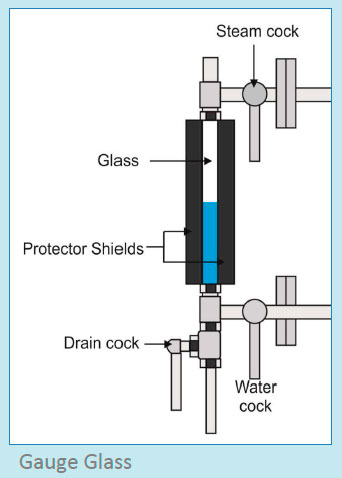
As it is an inspection glass and prone to breaking, gauge glass is fitted with additional safety to avoid the hot water or steam coming out of the boiler from injuring or burning the operator. A ball valve is fitted to the lower end of the gauge glass in order to shut-off the water in event of the glass breakage, else the water will blow out and the sudden reduction in the pressure will lead to flash off into scalding steam.
During normal operation, the ball valve sits down, as there is no flow of water inside the gauge glass. The ball sits down due to its own weight, uncovering the water inlet to the gauge glass. In case of glass breakage, the sudden flow of water pushes the ball to block the water inlet of the glass and stop the water flow.
Sample Valve: A sample valve is provided on the boiler drum whose outlet is installed in the engine room (mostly in the areas like workshop etc.) along with a cooler and a valve on the discharge point. This cooler is provided to safeguard the personnel from steam burn. The cooler is normally sea-water cooled.
Blow Down Valves: The boiler is fitted with two separate blow-down valves at different levels.
Bottom blow-down valve: It is fitted at the bottom side of the boiler and is used to remove sludge or sediments from the boiler. Usually a large (25 -50 mm) key operated valve is fitted at the shipside, along with an intermediate and a blow-down valve near the boiler. This valve might normally be opened for a period of about 5 seconds, once per shift, depending upon the dissolved sediments in the boiler water.
Scum blow down valve: The scum blow-down is fitted near the upper side of the boiler drum i.e. at the normal level of the boiler water in the steam drum. It is used to remove the floating impurities from the surface of the boiler water. The discharge of the scum blow down is also connected to the overboard line. A funnel is provided inside the boiler drum to scum the surface impurities once the scum blow down-valve is opened.
Other Notable Mountings:
- Supply valves for pressure gauge and sensors
- Waste heat recovery inlet and outlet valves
- Inspection hole
- Manhole door
- Furnace Drain valve
Boiler Internal Mountings
Just like external mountings, the steam drum of a boiler is also fitted with internal components, which help in increasing the efficiency of the produced steam. Important internals mountings used in boiler are:
Attemparator: It is a stack of ‘U’ tubes situated in the lower part of the steam drum and is always submerged in water. It is used to keep the super-heated steam temperature within certain desired limit in the final stage.
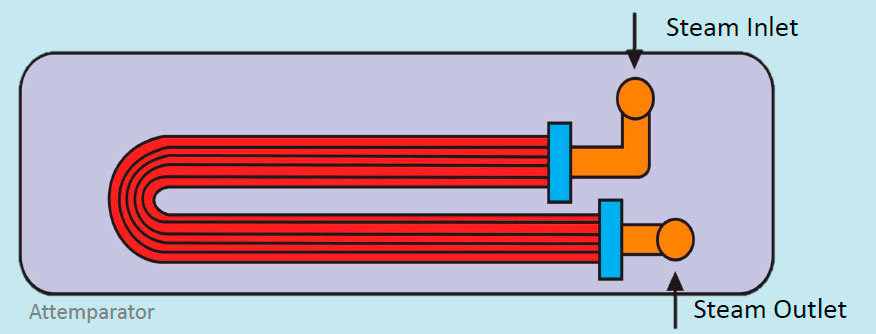
Cyclone Separator: Cyclone separator is similar to the filter, which is used to remove water droplets from the steam to avoid carry over of water in to the engine room systems.
Baffle Plates: Baffle plates are placed in the direction of the flow of steam. Its main function is to reduce the turbulence effect of the steam and to improve it’s purity.
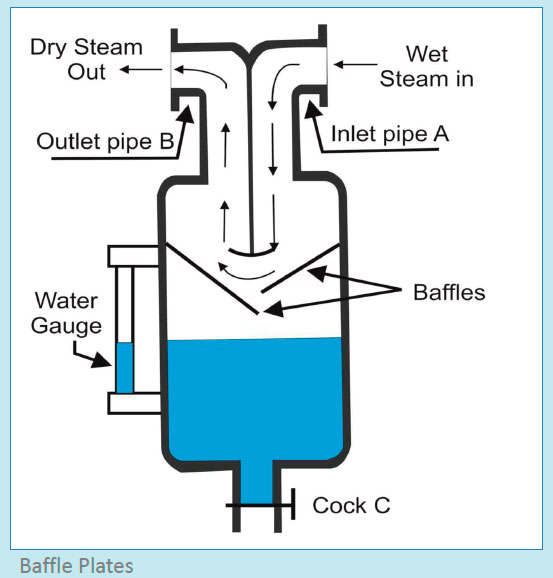
Chemical Dosing and Feed Water Pipe Inlet: The internal part of the steam drum is provided with pipe ends - one pipe end supplies chemical for dosing and the other pipe supplies the boiler feed water in the steam drum.
Scum Blow Down Funnel: A funnel is placed in the steam drum, almost at the boiler water level, to enable extraction of surface impurities from the water.
Problems in Boiler Mountings
Problems in Valves
Few common problems that are found in steam system valves are:
Leaking gland packing: This is the most common problem seen in the steam valves. It is due to temperature variation within the valve. Any damage to stem of the valve will lead to gland leakage.
Leaking valve seat: Valve seat is subjected to high pressure and velocity of steam, leading to wire drawing effect. Other damages such as scoring and pitting of the seat may also occur. If the valve is shut too tight, it may damage the seat.
Stuck up spindle: If the valve is not operated for a long period, the stem or spindle may get stuck due to impurities and deposits on the stem boundaries, which resist the turning of the spindle. Due to high temperature contact, the stem will expand and in presence of deposits, will have no room to turn.
Problems in gauge glass:
Wrong water level display: This may be due to impurities in the gauge glass inlet pipe. The other reason can be foaming in the boiler water, which will show wrong gauge glass level. If oil has taken access in the boiler water, it will appear in the gauge glass and the water level will not be at correct position.
Chocked water/steam side: Chocked water/ steam side can be due to lack of gauge glass maintenance (gauge glass blow down), which leads to salt deposits accumulating at the corners of the bends and pipes of the gauge glass. Blow down of gauge glass must be performed at least once a day to avoid this problem.
Stuck ball: The gauge glass comes with a ball which protects and stops the flow of high pressure and temperature water in case of breakage of gauge glass. If the gauge glass has not blown down for a long time, it may lead to salt deposits and can also make the ball stuck. This will not allow any water to come in the gauge glass. Blow down of gauge glass at least once a day is therefore very important.
Breakage of glass: The gauge glass can break due to any type of physical impact. This may lead to high-pressure hot water coming out of the boiler. Due to sudden decrease in the pressure (as surrounding area is at atmospheric pressure), most of the hot water will convert in to steam and lead to scalding injury to the nearby person.
Problems in safety valves easing gear:
Stuck wire: To lift the safety valve manually in the emergency situation, a steel wire with a handle is used at an accessible and safe place near the boiler. The wire runs through pulleys and connects to the safety valve spindle. Easing wire slipping out and getting stuck in the pulley are commonly found problems in the arrangement. It is therefore important to do a weekly inspection and greasing of the wires.
Jammed pulley: Pulley is a mechanical part, which rotates along a fixed point. Lack of greasing and accumulation of dust may lead to pulley getting stuck. Carry out weekly inspection and greasing of the wire to avoid this problem.
Stranding of the wire: The easing gear comprises of a steel wire connected to the safety valve at one end and lever at the other end. Improper maintenance and bad quality leads to stranding.
Removed link from the safety valve: The easing wire is connected to the safety valve with a quick link to lift the valve manually in case of an emergency. This quick link can be removed easily for maintenance purpose. If the link is not connected back to the valve, the easing gear will not work in emergency.
Problems in manhole doors:
Leaking manhole doors: The major problem with the manhole door of a marine boiler is the leakage of steam and water. It generally occurs if the boiler manhole was opened up for cleaning or inspection. Even if only one door was opened, the other intact manhole seals may also leak once the boiler is pressed up.
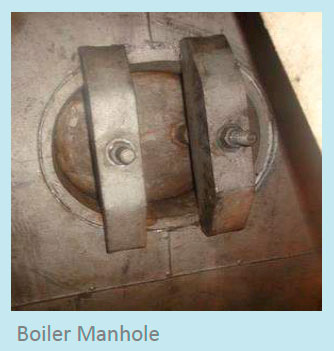
Problems in pressure transmitter and gauges:
Pressure transmitters and gauges provided in the boilers draw their inputs from the boiler drum via a small diameter copper pipe. Due to impurities and deposits in the boiler water, this copper pipe may get chocked, leading to wrong and erratic pressure readings. The boiler end of the copper pipe is provided with a small cock valve. Problem in this valve may also lead to wrong pressure readings in gauges and transmitter.
Maintenance of Boiler Mountings
Maintenance of Valves:
- The boiler comprises of different types of valves fitted as boiler mountings for transfer of water and steam to/from the boiler. The steam stop valve is of an angle pattern globe valve, which controls the supply of steam from the pressurized boiler
- The feed waterline is fitted with feed water stop valves after a feed water check valve to prevent the boiler from flooding by the static head from the boiler feed tank
- All the steam valves are to be checked for steam leakage from gland and body-bonnet joint. For a small gland leakage in the pressurized condition, cautiously tightening the gland packing may help in stopping the leakage; however, over tightening of the gland packing can damage the gland, leading to more steam coming out at high pressure and causing burns/ major accidents
- The best and safest way to stop any leakage from steam valve is to depressurize the boiler first. Once the boiler is at zero pressure, further time is to be given to cool down before removing any steam valve
- Overhauling of the complete valve is a good move and it will give a thorough idea about the condition of the complete valve
- Replace the gland packing with a new one even if the gland packing seems OK. Ensure the packing used is same as recommended by the makers
- Replace the joint between the body and the bonnet with steam joint
- Check the valve and valve seat for any damages, pitting and wire drawing effect
- Lap the valve and seat if required
- Check the trueness of the valve stem
- For feed water valve, isolate the feed water system and depressurize the boiler before opening any valve
- Check for gland packing and replace the same after removing the old packing
- Clean the valve and valve seat area from the water sediments
- Check for condition of valve and valve seat and lap them as required
- Renew the joint between the bonnet and the body
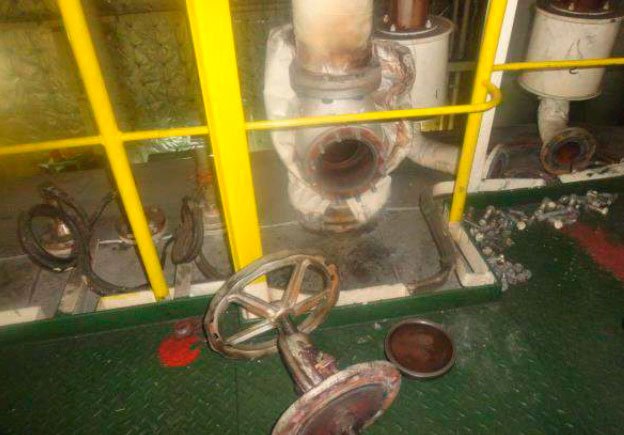
Maintenance of gauge glass:
The gauge glass of the boiler is important for monitoring safe water level inside the boiler. The engineer in-charge of the watch must blow down the boiler gauge glass to ensure the level displayed is always correct.
The gauge glass should also be thoroughly overhauled at each annual survey. Lack of maintenance can result in hardening of packing joint and seizure of cocks. If the cock handle becomes bent or distorted special care is to be given to ensure that the cock is set full open.
A damaged fitting should be renewed or repaired immediately. Gauge glasses often become discolored due to water conditions; they also become thin and worn out due to erosion. It is therefore advisable to renew gauge glasses at regular interval of time. A stock of spare glasses and cone packings should always be available in the boiler spare inventory.
Following things to consider when working on marine boiler water level gauge glasses:
- If steam passes are choked, a false high water level may be given in the gauge glass. After the gauge has been tested, a false high water level may still be indicated
- If the water passages are choked, an artificially high water level may be observed due to steam condensing in the glass. After testing, the glass will tend to remain empty unless the water level in the boiler is higher than the top connection of the gauge glass
- Gauge glass levels must be monitored with utmost attention as they are the only visual indicators of water level condition inside the boiler
- Any abnormal water level must be investigated as soon as it is observed, with immediate action taken to shut down the burner if necessary
Gauge glass blow down procedure:
To test the correct functioning of gauge glass, the following procedure should be followed:
- Close the water cock and open the drain cock for approximately 5 seconds
- Close the drain cock and open the water cock
- Water should return to its normal working level quickly. If this does not happen, then a blockage in the water cock could be the reason, and remedial action should be taken as soon as possible
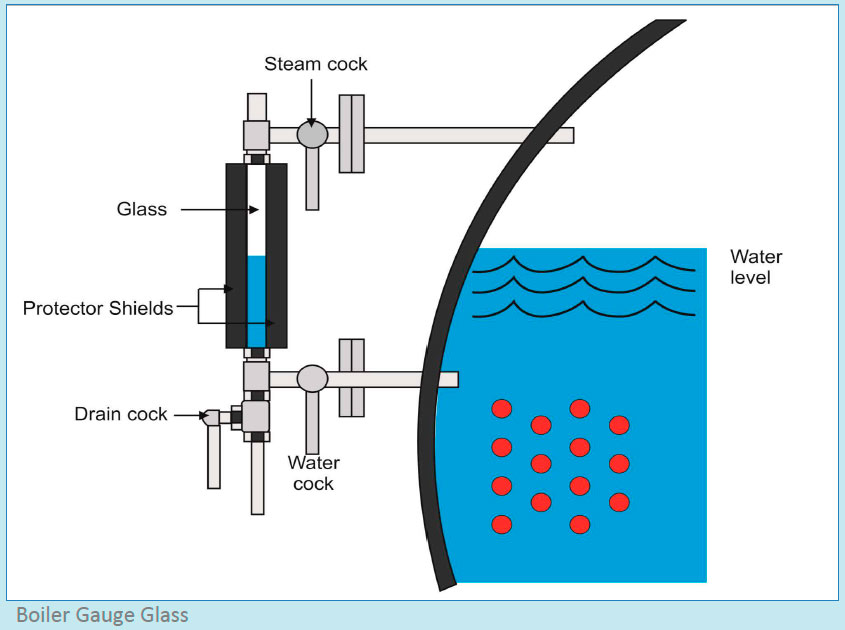
- Close the steam cock and open the drain cock for approximately 5 seconds
- Close the drain cock and open the steam cock
- If the water does not return to its normal working level quickly, a blockage may exist in the steam cock. Remedial action should be taken as soon as possible
The authorized officer should systematically test the water gauges at least once every day with suitable protection for face and hands, as a safeguard against scalding in the event of glass breakage.
Note: All handles of the gauge glass cocks should be pointing downwards when in the running condition.
Maintenance of glass and accessories:
- The protective guard of the gauge glass should be kept clean. When the guard is being cleaned in place, or removed for cleaning the gauge should be temporarily shut-off
- Make sure there is a sufficiently required water level in the boiler before shutting off the level gauges. Do not to touch or knock the gauge glasses when cleaning or replacing the guard. After guard maintenance, the gauge should be tested and the cocks should be set in the correct position
- If the glass needed is to be replaced, it is advisable to depressurize the boiler (even when the gauge glass cocks and valves are holding) before maintenance
- Clean the inside of the gauge for any sediments or deposits before replacing the glass
- If the complete gauge is removed for overhauling, check the condition of the safety ball valve and clean the seating of the same
- Always renew the gauge glass joint when replacing the glass
Maintenance of safety valves and easing gear:
The safety valves of the boiler must be overhauled and pressure tested as per the SOLAS requirements.
Following things need to be done for maintenance of safety valve:
- For overhauling the safety valve, depressurize the boiler and wait till the boiler cools down
- Remove the easing gear link
- Check for stamping or tag for last overhaul, pressure setting and description of the valve. Remove the tag or note down the stamping
- Mark the valves as 1 and 2 as per their pressure settings
- Check the condition of the valve and valve seat for pitting, burnout and wiredrawing effect
- Lap the valve and seat with recommended lapping paste
- Check the lip of the valve seat for any deformation
- Check the tension of the spring and trueness of the spindle
Monthly checks:
- Examine the safety valve drain for leakage/ water seepage
- Examine expansion device at the escape pipe
- Examine the lifting gear device, i.e. clean up and grease all sliding parts
Annual checks:
- The safety valve should be tested in operation by raising the boiler pressure
- Expansion and exhaust pipe should be examined at the same time
References
A Guide to Boiler Operation and Maintenance Construction and Design. Anish Wankhede [2015]

